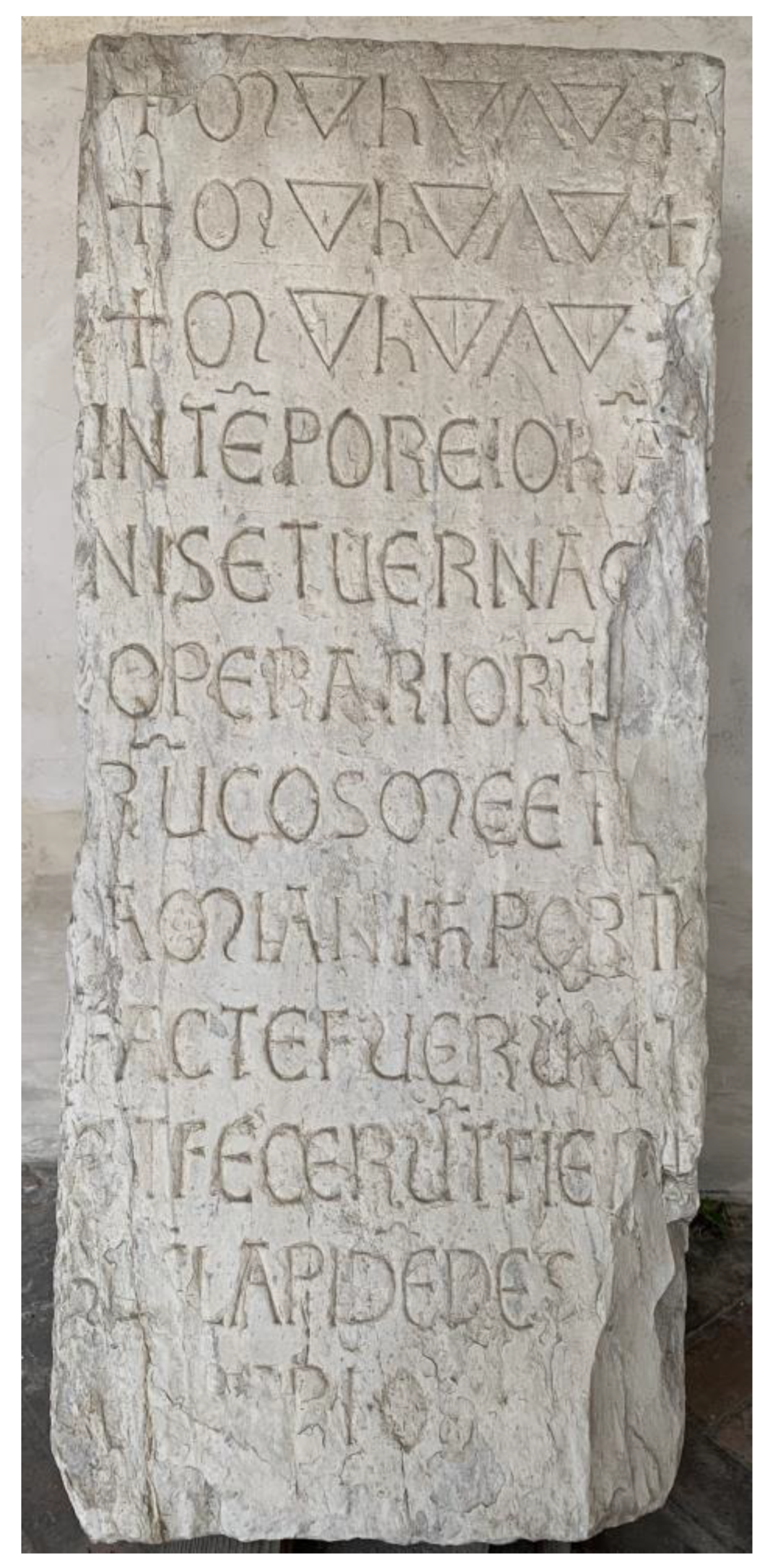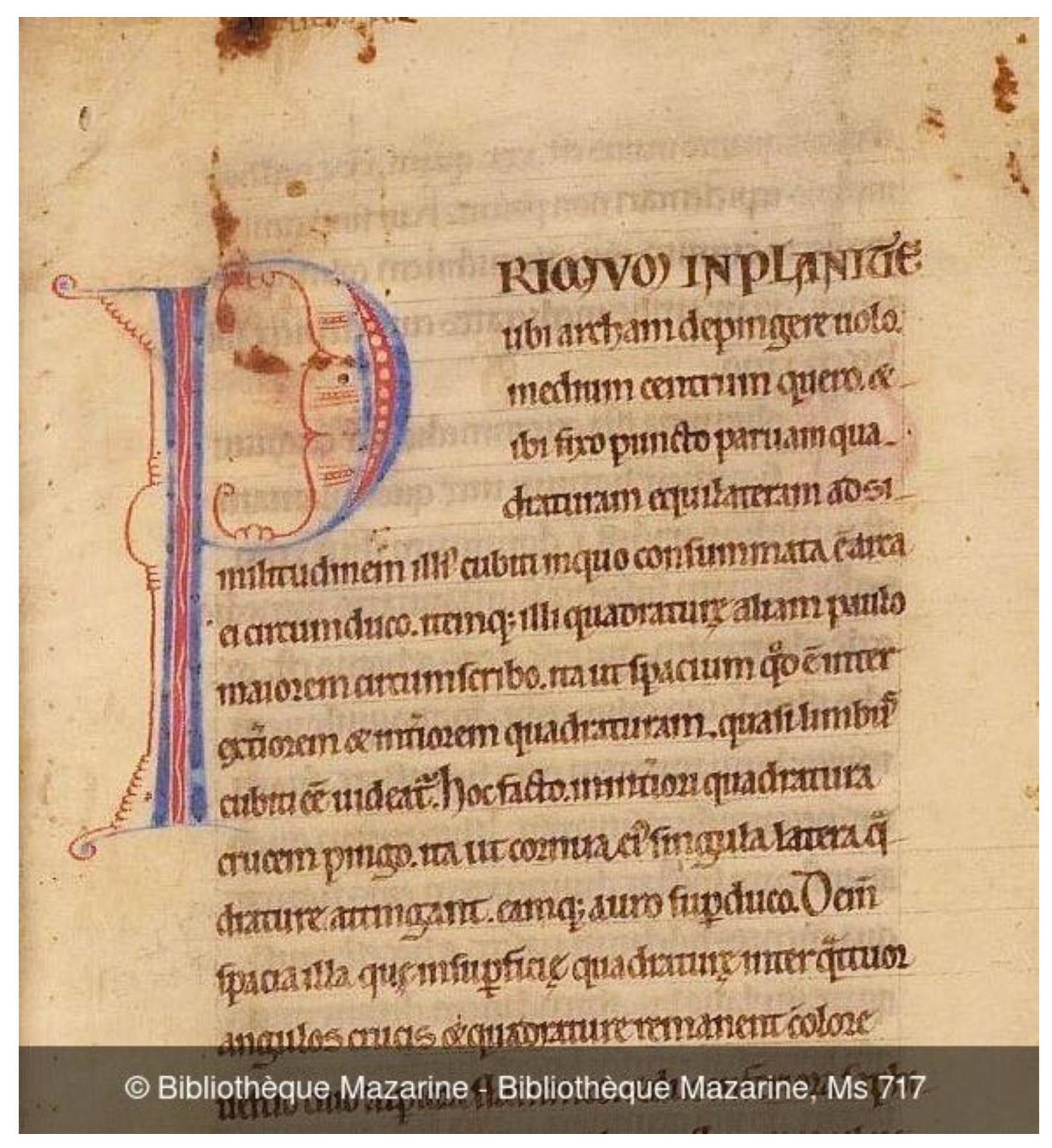Submitted:
19 May 2023
Posted:
22 May 2023
Read the latest preprint version here
Abstract
Keywords:
1. Introduction
2. Materials
2.1. Literature review
2.2. Context
2.3. Method
- A text near the door of a religious building, visible to all the believers, was probably an interesting message, easily comprehensible;
- The characters had to be part of the same alphabet, in the same version; this excludes as low probable a mixt of Latin and Greek letterers, or a mixt of recent and archaic style; both could represent an great obstacle for the readers;
- In a church we expect messages reinforcing the religious traditions, referring to episodes of Holy texts or to figures relevant in the religious hierarchy.
3. Results
3.1. Deciphering
3.2. Interpretation of the message
- -
- “M H” to indicate Michael,represented on a denarius of King Adelchis (Anno Domini 853-878) ;
- -
- “MIHA” to indicate Michael Archangelus on a denarius of King Radelchis II (Anno Domini 881-884), (Wroth, 1911, p.185-187).
4. Discussion
- -
- The insertion of apotropaic texts near the door of a house is widely adopted during the Roman era, especially against aversion to natural events. In the Middle Ages the triple call to San Michele, who fights a dragon, recalls the fear of Evil influxes, so the main fears became supernatural.
- -
- A believer calls for the aid of the Saint in a form of purification. It is evident in the inscription on the Baptistery of Pisa that Saint Michael and the christening are both a supports to save the soul.
- -
- Saint Michele, Michael, is a warrior and in an era of violence, when the society was dominated by a group of warriors, there is no surprise to his large popularity.
- -
- The contrast described in the inscription of Barga is between two angels: Saint Michael, the chief of positive angels and Evil/Lucifer, a fallen angel.
- -
- The repeated reference to the number three puts in evidence the special role of this number in the religion. More than one thousand years before it was already part of the rituals of Etruscan and Raetic, populations that created the protohistoric cultural substrate of the Italian Peninsula, where towns of Lucca and Pisa are inserted.
Author Contributions
Funding
Acknowledgments
Conflicts of Interest
References
- Banti, O. (1975). Simbolismo religioso e stilizzazione grafica in una iscrizione longobarda del secolo VIII. Studi Medioevali, XVI(3), 241–258.
- Durando, G. (1612). Rationale Divinorum Officiorum (Sumptibus P. R. Apud haeredes Gulielmi Rouillii, Ed.). https://archive.org/details/rationalediuinor01dura/page/n539/mode/2up?q=dicimus.
- ElShanawany, H. (2022). THE DECIPHERMENT OF THE INSCRIPTION OF THE BAPTISTERY OF PISA. Academia Letters, 1–3. https://www.academia.edu/51125775/The_Undeciphered_Inscription_of_the_Baptistery_. Available online: https://www.academia.edu/51125775/The_Undeciphered_Inscription_of_the_Baptistery_.
- Graziosi, G. (2022). Cenni di storia e monetazione longobarda. Www.Fdocuments.Net. Available online: https://www.panorama-numismatico.com/wp-content/uploads/CENNI-DI-STORIA-E-MONETAZIONE-LONGOBARDA.pdf.
- Hugues de Saint.Victor. (1141). Recueil de textes d’Hugues de Saint-Victor. De Vanitate Rerum Mundanarum Ms0717, f 093v. Available online: https://bibnum.institutdefrance.fr/records/item/1896-recueil-de-textes-d-hugues-de-saint-victor?offset=6.
- Mancini, A. (1956). Ancora sull’iscrizione criptografica di Pisa e di Barga. Atti Dell’Accademia Nazionale Dei Lincei, XI(5–6), 134–136.
- Marangoni, G. (1763). Grandezze dell’arcangelo San Michele. Gallarini. Available online: https://www.google.it/books/edition/Grandezze_dell_arcangelo_San_Michele_etc/9dZYAAAAcAAJ?hl=it&gbpv=1&dq=grandezze+dell%27arcangelo+michele&printsec=frontcover.
- Pasini, D. (2015). Daria Pasini Ancora sull’epigrafe con triplice invocazione… pp. Rivista Di Archeologia e Restauro, 10(1), 18–24.
- Perono Cacciafoco, F. (2021). The Undeciphered Inscription of the Baptistery of Pisa. Academia Letters. [CrossRef]
- Targioni Tozzetti, G. (1768). Relazioni d’alcuni viaggi fatti in diverse parti della Toscana per osservare le produzioni naturali e gli antichi monumenti di essa. Firenze. Available online: https://www.google.it/books/edition/Relazioni_d_alcuni_viaggi_fatti_in_diver/bGdiywAACAAJ?hl=it.
- Wroth, W. W. (1911). Catalogue of the coins of the Vandals, Ostrogoths and Lombards, and of the empires of Thessalonica, Nicaea and Trebizond in the British Museum: British Museum. Dept. of Coins and Medals : Free Download, Borrow, and Streaming : Internet Archive. Longmans & Co. Available online: https://archive.org/details/catalogueofcoins00britrich/page/n3/mode/2up.








Disclaimer/Publisher’s Note: The statements, opinions and data contained in all publications are solely those of the individual author(s) and contributor(s) and not of MDPI and/or the editor(s). MDPI and/or the editor(s) disclaim responsibility for any injury to people or property resulting from any ideas, methods, instructions or products referred to in the content. |
© 2023 by the authors. Licensee MDPI, Basel, Switzerland. This article is an open access article distributed under the terms and conditions of the Creative Commons Attribution (CC BY) license (http://creativecommons.org/licenses/by/4.0/).



